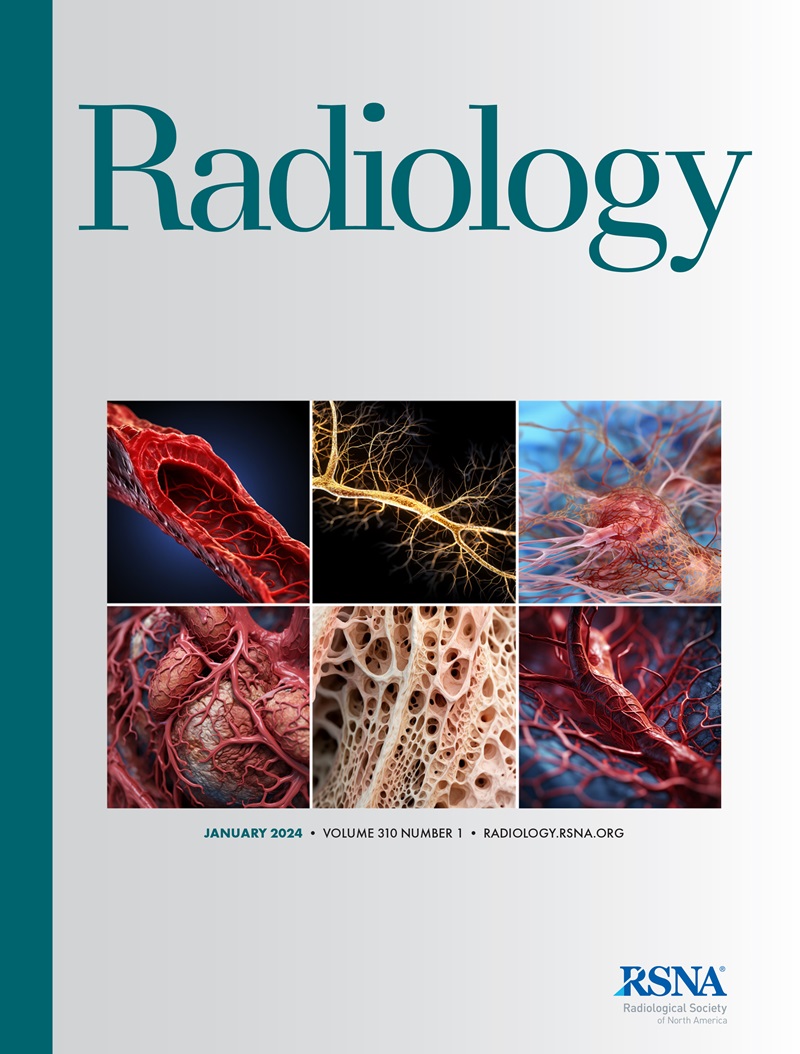Jiyoung Yoon, Kyunghwa Han, Seungchan Nahm, Min Jung Kim, Jung Hyun Yoon, Miribi Rho, Vivian Youngjean Park
求助PDF
{"title":"Surveillance Breast MRI in Women with a History of Breast Cancer: Association with Occurrence of Advanced Second Breast Cancer.","authors":"Jiyoung Yoon, Kyunghwa Han, Seungchan Nahm, Min Jung Kim, Jung Hyun Yoon, Miribi Rho, Vivian Youngjean Park","doi":"10.1148/radiol.240119","DOIUrl":null,"url":null,"abstract":"<p><p>Background Studies on the association between surveillance breast MRI in women with a personal history of breast cancer (PHBC) and advanced second breast cancer are lacking. Purpose To investigate the association between postoperative surveillance breast MRI and advanced second breast cancer in women with a PHBC by using propensity score matching (PSM). Materials and Methods Women who underwent breast cancer surgery between January 2009 and December 2014 were retrospectively identified at a single tertiary center. Second breast cancer was defined as ipsilateral or contralateral breast cancer diagnosed at least 1 year after surgery, and advanced second breast cancer was defined as second breast cancer <i>(a)</i> grade T2 or higher or lymph node-positive or <i>(b)</i> T1c triple-negative or human epidermal growth factor receptor 2-positive. Women who underwent surveillance MRI and those who did not were matched using propensity scores according to 13 clinical-pathologic characteristics. Outcomes were compared using logistic regression analysis. Results Among the 3688 women (mean age, 51.1 years ± 10.5 [SD]), 2130 underwent surveillance MRI (MRI group) and 1558 did not (non-MRI group); 1062 patient pairs were matched. Advanced second breast cancer proportions for non-MRI and MRI groups were 1.7% (27 of 1558 participants) and 0.4% (eight of 2130 participants) before PSM and 1.6% (17 of 1062 participants) and 0.7% (seven of 1062) after PSM. Surveillance MRI was associated with lower odds of advanced second breast cancer before PSM (odds ratio [OR], 0.21 [95% CI: 0.10, 0.47]; <i>P</i> < .001) and after PSM (OR, 0.41 [95% CI: 0.17, 0.99]; <i>P</i> = .048). The proportion of symptomatic second breast cancers was higher in the non-MRI group before PSM (25% [16 of 65 second cancers] vs 6.4% [three of 47]; <i>P</i> = .01) and after PSM (21% [10 of 48] vs 3.2% [one of 31]; <i>P</i> = .003). Conclusion In women with a PHBC, MRI surveillance was associated with lower odds of advanced second breast cancer before and after PSM. © RSNA, 2025 <i>Supplemental material is available for this article.</i></p>","PeriodicalId":20896,"journal":{"name":"Radiology","volume":"314 1","pages":"e240119"},"PeriodicalIF":12.1000,"publicationDate":"2025-01-01","publicationTypes":"Journal Article","fieldsOfStudy":null,"isOpenAccess":false,"openAccessPdf":"","citationCount":"0","resultStr":null,"platform":"Semanticscholar","paperid":null,"PeriodicalName":"Radiology","FirstCategoryId":"3","ListUrlMain":"https://doi.org/10.1148/radiol.240119","RegionNum":1,"RegionCategory":"医学","ArticlePicture":[],"TitleCN":null,"AbstractTextCN":null,"PMCID":null,"EPubDate":"","PubModel":"","JCR":"Q1","JCRName":"RADIOLOGY, NUCLEAR MEDICINE & MEDICAL IMAGING","Score":null,"Total":0}
引用次数: 0
引用
批量引用
Abstract
Background Studies on the association between surveillance breast MRI in women with a personal history of breast cancer (PHBC) and advanced second breast cancer are lacking. Purpose To investigate the association between postoperative surveillance breast MRI and advanced second breast cancer in women with a PHBC by using propensity score matching (PSM). Materials and Methods Women who underwent breast cancer surgery between January 2009 and December 2014 were retrospectively identified at a single tertiary center. Second breast cancer was defined as ipsilateral or contralateral breast cancer diagnosed at least 1 year after surgery, and advanced second breast cancer was defined as second breast cancer (a) grade T2 or higher or lymph node-positive or (b) T1c triple-negative or human epidermal growth factor receptor 2-positive. Women who underwent surveillance MRI and those who did not were matched using propensity scores according to 13 clinical-pathologic characteristics. Outcomes were compared using logistic regression analysis. Results Among the 3688 women (mean age, 51.1 years ± 10.5 [SD]), 2130 underwent surveillance MRI (MRI group) and 1558 did not (non-MRI group); 1062 patient pairs were matched. Advanced second breast cancer proportions for non-MRI and MRI groups were 1.7% (27 of 1558 participants) and 0.4% (eight of 2130 participants) before PSM and 1.6% (17 of 1062 participants) and 0.7% (seven of 1062) after PSM. Surveillance MRI was associated with lower odds of advanced second breast cancer before PSM (odds ratio [OR], 0.21 [95% CI: 0.10, 0.47]; P < .001) and after PSM (OR, 0.41 [95% CI: 0.17, 0.99]; P = .048). The proportion of symptomatic second breast cancers was higher in the non-MRI group before PSM (25% [16 of 65 second cancers] vs 6.4% [three of 47]; P = .01) and after PSM (21% [10 of 48] vs 3.2% [one of 31]; P = .003). Conclusion In women with a PHBC, MRI surveillance was associated with lower odds of advanced second breast cancer before and after PSM. © RSNA, 2025 Supplemental material is available for this article.
有乳腺癌病史的女性的乳腺MRI监测:与晚期第二乳腺癌发生的关系
背景:有个人乳腺癌病史(PHBC)的女性的乳腺MRI监测与晚期第二乳腺癌之间的关系尚缺乏相关研究。目的应用倾向评分匹配(PSM)方法探讨PHBC患者术后乳腺MRI监测与晚期第二乳腺癌的关系。材料和方法回顾性分析2009年1月至2014年12月在单一三级中心接受乳腺癌手术的妇女。第二乳腺癌被定义为术后至少1年确诊的同侧或对侧乳腺癌,晚期第二乳腺癌被定义为第二乳腺癌(a) T2级或以上或淋巴结阳性或(b) T1c三阴性或人表皮生长因子受体2阳性。根据13项临床病理特征,使用倾向评分对接受核磁共振监测的妇女和未接受监测的妇女进行匹配。结果采用logistic回归分析进行比较。结果在3688名女性(平均年龄51.1岁±10.5岁[SD])中,2130名女性接受了MRI监测(MRI组),1558名女性未接受MRI监测(非MRI组);1062对患者配对。非MRI组和MRI组的晚期第二乳腺癌比例在PSM前分别为1.7%(1558名参与者中的27名)和0.4%(2130名参与者中的8名),在PSM后分别为1.6%(1062名参与者中的17名)和0.7%(1062名参与者中的7名)。MRI监测与PSM前发生晚期第二乳腺癌的几率较低相关(优势比[OR], 0.21 [95% CI: 0.10, 0.47];P < 0.001)和PSM后(OR, 0.41 [95% CI: 0.17, 0.99];P = .048)。PSM前非mri组出现症状性二次乳腺癌的比例更高(25%[65例中有16例]vs 6.4%[47例中有3例];P = 0.01)和PSM后(21% [48 / 10]vs 3.2% [31 / 1];P = .003)。结论:在PHBC患者中,MRI监测与PSM前后晚期第二乳腺癌的发生率较低相关。©RSNA, 2025本文可获得补充材料。
本文章由计算机程序翻译,如有差异,请以英文原文为准。

 求助内容:
求助内容: 应助结果提醒方式:
应助结果提醒方式:


